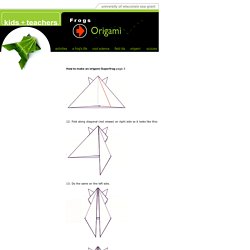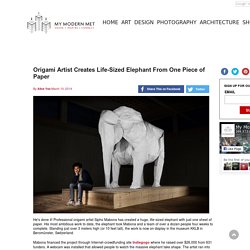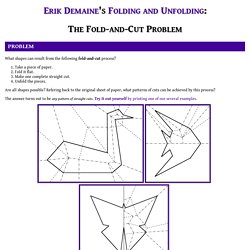

Researchers explore potential of origami for large foldable structures. Sep 14, 2015 researchers explore potential of origami for large foldable structures researchers explore potential of origami for large foldable structures (above) glaucio paulino, georgia tech professor and evgueni filipov, illinois gradaute researcherall images courtesy of university of illinois researchers from the university of illinois at urbana-champaign, the georgia institute of technology and the university of tokyo have developed a new ‘zippered tube’ configuration that makes paper forms that are stiff enough to hold weight, yet can fold flat for shipping and storing. the method could be applied to other thin materials, from plastics to metals, to transform structures from furniture to buildings to microscopic robots.

How to Make Origami Frogs page 3 - University of Wisconsin Sea Grant. How to make an origami Superfrog page 3 12.

Fold along diagonal (red crease) on right side so it looks like this: 13. Do the same on the left side. 14. 15. 16. So it ends up like this: 17. 18. 19. Simple origami fold may hold the key to designing pop-up furniture, medical devices and scientific tools. What if you could make any object out of a flat sheet of paper?

That future is on the horizon thanks to new research by L. Mahadevan, the Lola England de Valpine Professor of Applied Mathematics, Organismic and Evolutionary Biology, and Physics at the Harvard John A. Paulson School of Engineering and Applied Sciences (SEAS). He is also a core faculty member of the Wyss Institute for Biologically Inspired Engineering, and member of the Kavli Institute for Bionano Science and Technology, at Harvard University. Mahadevan and his team have characterized a fundamental origami fold, or tessellation, that could be used as a building block to create almost any three-dimensional shape, from nanostructures to buildings.
The folding pattern, known as the Miura-ori, is a periodic way to tile the plane using the simplest mountain-valley fold in origami. "Could this simple folding pattern serve as a template for more complicated shapes, such as saddles, spheres, cylinders, and helices? " Origami Artist Creates Life-Sized Elephant From One Piece of Paper. He's done it!

Professional origami artist Sipho Mabona has created a huge, life-sized elephant with just one sheet of paper. His most ambitious work to date, the elephant took Mabona and a team of over a dozen people four weeks to complete. Standing just over 3 meters high (or 10 feet tall), the work is now on display in the museum KKLB in Beromünster, Switzerland. Mabona financed the project through Internet-crowdfunding site Indiegogo where he raised over $26,000 from 631 funders.
A webcam was installed that allowed people to watch the massive elephant take shape. Mabona Origami websitePhoto credit: Philipp Schmidli. Mathematician Shows How to Make Any Shape From a Single Cut. 4464 12ShareNew Mathematicians don’t approach the world quite like the rest of us.

Case in point: Katie Steckles. The Manchester-based mathematician was trying to cut a square out of a piece of paper and started to wonder about the most efficient way to do so. Her queries led her to some experimentation (turns out it can be done with one snip), and then to the pub, where she wondered aloud whether there were other shapes that could be made with one cut. Her companion asked, “Isn’t that a theorem?” Indeed it is. [h/t The Kids Should See This] Whitepapersculptures10. World’s First Origami Car Unveiled. LEXUS have designed and made the Origami Car, with the help of Scales and Models.

The car is made from 1700 individually cut pieces of cardboard, and will be on display at the Grand Designs Live show, at the NEC in Birmingham, England, from October 8th to 11th, 2015. Paperairplanescollection-0 – Fubiz Media. Researchers Invent Surprisingly Strong Origami Structures That Fold Flat. Take a floppy material like paper and add a series of bends like you’d find in corrugated cardboard, and you get a shockingly strong structure.

That’s the basic idea used in the origami inspired structure invented by three researchers collaborating from different sides of the world. Their “Zippered Tube” technique uses paper or paper-like material, cutting it into a zig-zag pattern and then attaching it together into a long, tube-like structure. The best part?
The tubes quickly fold flat. A video explains the technique way better than words. Applications for this tech abound. The Fold-and-Cut Problem (Erik Demaine) Problem What shapes can result from the following fold-and-cut process?

Take a piece of paper. Fold it flat. Make one complete straight cut. Unfold the pieces. The answer turns out to be any pattern of straight cuts. History The first published reference to folding and cutting of which we are aware is a Japanese book, Wakoku Chiyekurabe (Mathematical Contests), by Kan Chu Sen, published in 1721.
Another early reference to folding and cutting is a July 1873 article “National Standards and Emblems” in Harper's New Monthly Magazine, volume 47, number 278.